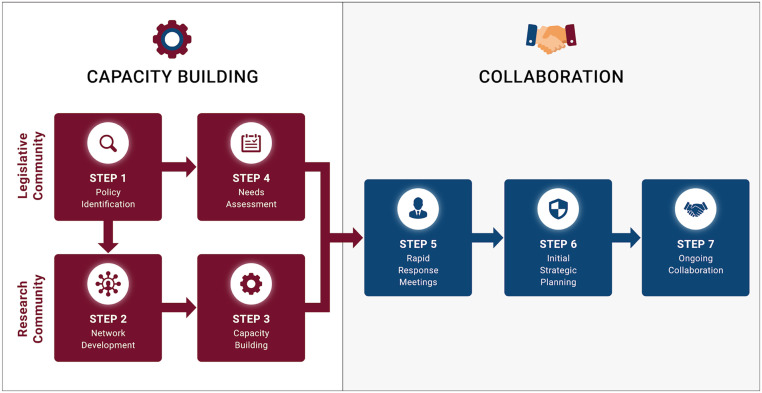Fig. 1.
The RPC Intervention Model. Step 1: Policy Identification involves initial outreach to legislative staff and uses a semistructured needs assessment to inquire about policymakers’ overarching policy goals for the legislative session. Step 2: Rapid Response Network Development involves identifying researchers who have expertise relevant to policymakers’ goals and are willing to contribute to research translation efforts. Their areas of expertise are cataloged in a strategic resource mapping process that builds capacity for matching researchers with policymakers. Step 3: Network Capacity Building occurs through didactic and experiential training that aims to increase policy skills and engagement. This includes training on adapting to legislative norms without violating lobbying regulations, as well as opportunities to respond to lawmakers’ interests identified in Step 1. Step 4: Legislative Needs Assessment identifies short-term priorities and needs in anticipation of matching policymakers with researchers who have corresponding experiences and scholarly interests. This semistructured assessment is action-oriented to identify ways that researchers might support legislative efforts. Step 5: Rapid Response Meetings engage legislative staff and researchers in direct interactions to discuss research, as this is a theorized mechanism for facilitating relationship development. Meetings aim to support the codevelopment of science implications, since research interpretation is a formative and iterative process. Researchers respond to initial legislative requests and plan next steps for ongoing collaboration. Researchers are invited for these meetings based on prior RPC participation, time availability, relevant scholarly interests, and geographic similarities (e.g., researchers having done work in the state the congressional member represents). Step 6: Initial Strategic Planning for rapid responses follows immediately after meetings to summarize goals, determine next steps, prioritize and create a timeline, and identify point person(s) for follow-up. Step 7: Ongoing Collaboration includes rapid responses to legislative requests. As an example, this could include collecting and summarizing research resources, planning briefing events or testimony, or publishing written products for dissemination (e.g., briefs, op-eds).

